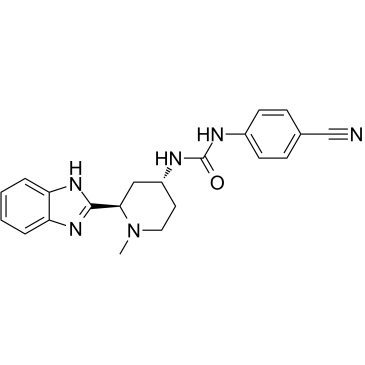| Cas No.: | 1095173-27-5 |
| Chemical Name: | Glasdegib (PF-04449913) |
| Synonyms: | PF04449913; PF-04449913; PF 04449913; PF4449913; PF-4449913; PF 4449913; Glasdegib. |
| SMILES: | O=C(NC1=CC=C(C#N)C=C1)N[C@H]2C[C@H](C3=NC4=CC=CC=C4N3)N(C)CC2 |
| Formula: | C21H22N6O |
| M.Wt: | 374.44 |
| Sotrage: | 2 years -20°C Powder, 2 weeks 4°C in DMSO, 6 months -80°C in DMSO |
| Description: | Glasdegib (PF-04449913) is a potent and orally bioavailable smoothened inhibitor. Glasdegib (PF-04449913) binds to human SMO (amino acids 181-787) with an IC50 of 4 nM. |
| In Vivo: | Human BC LSC engrafted RAG2-/-γC-/- mice treated daily with Glasdegib (PF-04449913) compared with vehicle treated controls had a significant spleen weight reduction (p=0.006). When CD34+ cord blood engrafted NSG mice are treated with Glasdegib (PF-04449913), the frequency of human CD45+ cells, progenitors and both myeloid and lymphoid cell fate commitment remained comparable to vehicle treated controls indicating that unlike LSC, normal human HSC cell fate decisions are Hh pathway independent. These results highlight the important niche dependent effects of selective SMO inhibition that induce GLI2 downregulation in a cell type and context specific manner[1]. |
| In Vitro: | Glasdegib (PF-04449913) inhibits sonic hedgehog (Shh) stimulated luciferase expression in mouse embryonic fibroblasts with an IC50 of 6.8 nM; and significantly reduces medulloblastoma growth in a Ptch1+/-p53+/- allograft model at doses that decreased murine Shh target gene expression. In stromal co-culture experiments, FACS analysis demonstrates a significant reduction in BC LSC by Glasdegib (PF-04449913) when compared with normal progenitors. Importantly, human BC LSC engrafted RAG2-/-γC-/- mice treated daily with Glasdegib (PF-04449913) compared with vehicle treated controls have a significant spleen weight reduction (p=0.006). This reduction in leukemic burden corresponded with decreased GLI2 protein expression, as determined by both nanoproteomic analysis of FACS purified human progenitors and GLI2 confocal fluorescence microscopic analysis of splenic sections[1]. |






















